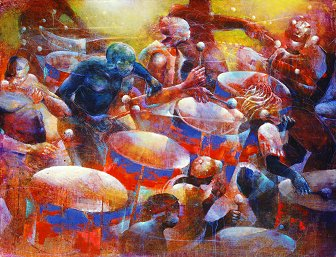History
Steelpan Origins
"For over 50 years the world has enjoyed the scintillating, pulsating music of the steelband. Audiences from London to New York and beyond have been left spellbound, amazed that such rich tonal quality could come from discarded oil drums. The refined sound we now hear is the result of decades of hard work, research and innovations by master tuners such as Ellie Mannette, Neville Jules, Bertie Marshall, Anthony Williams, Rudolph Charles and Lincoln Noel to name a few. But how and where did it all start?


There are varying accounts as to the exact date and location in Trinidad the first steelpan was tuned since no official records were kept by either the pioneers or the British colonial government of the day. This, however, is one popular version. Necessity, it is said, is the mother of all inventions, and the steelpan is sound proof of that maxim. It was born out of deprivation, a desperate need by a people to fill the void that was left when something central to their existence was taken away.
Since the 1800s, the inhabitants of Trinidad had been participating in a street carnival brought to the Caribbean island by the French. When the freed slaves (slavery was abolished in the West Indies in 1834) joined in the festivities, they could not afford the conventional instruments, so they used African drums, the instruments of their ancestors, then created percussion bands made up of bamboo joints cut from the bamboo plant. The 'Tamboo Bamboo' bands (tamboo is a corruption of the French word tambour which means drum) bands were rhythmic ensembles that provided the accompaniment for the masqueraders in the annual parade.
Throughout the 1920s and 30s these bands flourished, but by 1940 something dreadful was about to plunge the world into perhaps its darkest and most notorious period in the twentieth century. Unwittingly, the events of that dark era would provide the beam that lit the way to the discovery of a new musical instrument.
When Adolf Hitler drew Europe into World War Two, the British colonial government summarily banned the Tamboo Bamboo bands, forcing the people to look for other ways to make merry. Readily available were steel drums discarded by the oil refineries on the island.
As they banged against the flat surface of the drum, the fun seekers accidentally stumbled upon a sound that would lead to further experimentations, and consequently, the birth of steelpan, the only musical invention of the twentieth century.
While death and destruction consumed Europe in the early forties, the lives of the underprivileged, unemployed young men in Trinidad were filled with hope and excitement. They realized that the constant pounding against the flat end of the drum left an indentation, and the sound changed as well. Word would soon spread about the discovery, and the possibility of making music with the drums. Further experiments would follow. To achieve further indentation, they would heat the drums in bonfires. What they discovered too was that by varying the size and depth on the indentation, it was possible to get more notes with different tones. As the creativity of these youths took over, one note led to two, three, then four on a single drum.
When the war ended in 1945, Trinidadians, like most people around the world, took to the streets in celebration, carrying of course, their new instruments. While they made music, there were still limitations. They needed an instrument on which an eight-note scale could be played. Who would be the first to tune such an instrument?
